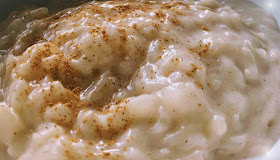Exceptional food that worth a special journey. And all other foods that can kill you.
Pages
▼
Wednesday
How to Make Jasmine Rice Pudding- Quick Recipe for Jasmine Rice Pudding without Coconut Milk
Creamy Jasmine Rice Pudding for All Seasons
This is a classic rice pudding of everyone’s childhood. It is sweet and creamy, no fancy or exotic ingredients.
This one is not a traditional stove top creamy jasmine rice pudding recipe
But this is one of my all-time favorites. The basic mixture of cooked jasmine rice, milk, and egg can become the basis for many exciting flavor combinations.
During summer, I fold whipped cream into the rice and then gently fold sweetened berries into the mixture. In winter, I stew dried fruits and fold them into the rice and cream. You can also use any of the spoon fruits or sauces available.
Whole milk is best, but 2 percent works fine. It is slowly simmered in the rice cooker and ready to eat as soon as it cools. Remember that rice pudding thickens considerably when chilled as the starch in the rice sets up.
YIELD: Serves 6
INGREDIENTS:
2/3 cup Jasmine rice
4 cups milk
1 large egg
1/3 cup sugar
1 teaspoon pure vanilla extract
COOKING DIRECTIONS:
MACHINE: Medium (6-cup) rice cooker; fuzzy logic only
CYCLE: Porridge
1) Place the rice and milk in the rice cooker bowl; stir to combine. Close the cover and set for the Porridge cycle.
2) When the machine switches to the Keep Warm cycle, combine the egg, sugar, and vanilla in a small bowl and beat with a whisk. Open the rice cooker, spoon a few tablespoons of the rice milk into the egg mixture, and beat with a wooden spoon. Beating the rice milk constantly, pour the egg mixture into the rice cooker bowl. Stir for a minute to combine. Close the cover and reset for a second Porridge cycle. Stir every 15 to 20 minutes until the desired thickness is reached.
3) Pour the pudding into 6 custard cups or ramekins. Serve warm or let cool slightly and refrigerate for at least 1 hour. When cold, cover with plastic wrap and store for up to 4 days.
RICE PUDDING VARIATIONS:
RICE PUDDING WITH STEWED DRIED APRICOTS. Flavor the rice pudding with ¼ teaspoon almond extract in addition to the vanilla. Combine 8 ounces dried apricots, 1½ cups water, and a cinnamon stick in a small saucepan.
Heat to a simmer; cover and cook, stirring occasionally, over low heat for 15 minutes or until the apricots are very soft and most of the liquid is absorbed. Let cool slightly. Remove the cinnamon stick.
Stir the apricots to break them up into loose, rough pieces. Let cool. Fold the apricot compote into the plain rice pudding or the version lightened with whipped cream.
RICE PUDDING WITH SWEETENED BERRIES. Combine 2 cups berries (cut-up strawberries mixed with raspberries and blueberries, or any combination) with 2 tablespoons sugar in a bowl; stir to blend.
Let stand until juicy. Fold into the plain rice pudding or the version lightened with whipped cream.
Related Recipes: WHAT SHOULD I EAT FORE DINNER?
1) What Should I have for Dinner? Try this Jewish Noodle Pudding Recipe
2) What Should I Eat for Dinner? Try this Easy Hasty Pudding Recipe
PUDDING COOKING TIPS
Sweet Pudding Basics
1) Basmati rice makes a fragrant pudding, but will not be as creamy as pudding made with regular long-grain rice. Short-and medium-grain rice formulates the creamiest puddings.
2) Sugar will interfere with the ability of the rice to absorb the milk. Therefore, when making pudding with uncooked rice cook it first in the milk (or other liquid) before adding the sugar, or be prepared for the rice to take longer to cook.
3) The soft texture of the rice in warm pudding will change when the pudding is chilled. The hardness can be lessened by using soft cooked rice (cook it for a longer period of time) or reversed by reheating the pudding in a microwave, in a boiling water bath in a warm oven, or a double boiler.
4) Milk, sugar, and rice—the three main ingredients in pudding—scorch easily. Use a heavy saucepan and stir often over low heat.
REFERENCES:
Beth Hensperger. 2012. The Ultimate Rice Cooker Cookbook: 250 No-Fail Recipes for Pilafs, Risottos, Polenta, Chilis, Soups, Porridges, Puddings, and More, from Start to Finish in Your Rice Cooker, Revised edition. Harvard Common Press. ISBN-10: 1558326677
Marie Simmons. 2002. The Amazing World of Rice: with 150 Recipes for Pilafs, Paellas, Puddings, and More, 1st edition. William Morrow Cookbooks. ISBN-10: 0060938420

No comments:
Post a Comment